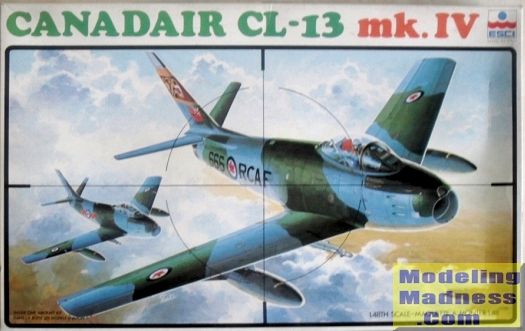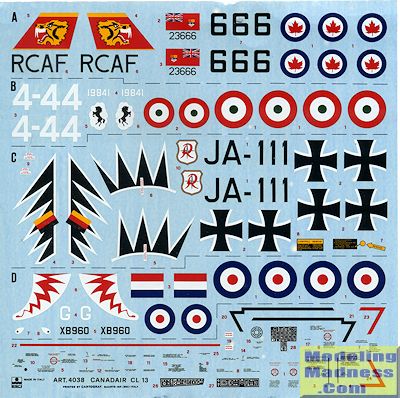
ESCI 1/48 Canadair CL-13/Sabre Mk 4-6
| KIT # | 4038 |
| PRICE: | $3.00 from the 'junk kit' table |
| DECALS: | Four aircraft |
| REVIEWER: | |
| NOTES: |

| HISTORY |
| THE KIT |
 The first 1/48 Sabre was, to my knowledge, the Monogram kit which was a 6-3 wing plane with wing fences. It has been reissued a ton of times. About this same time, ESCI decided to join the Sabre club. They produced a kit that could allegedly be done as an FJ-2 as well, but the only things similar to the FJ-2 was a two cannon insert and the rather unusual canopy used by the FJ-2. Note that I've used the image of the FJ-2 kit sprues as they are pretty much the same. I should mention that this particular kit was bought minus the main wheels, hence a 'junk table' rescue kit.
The first 1/48 Sabre was, to my knowledge, the Monogram kit which was a 6-3 wing plane with wing fences. It has been reissued a ton of times. About this same time, ESCI decided to join the Sabre club. They produced a kit that could allegedly be done as an FJ-2 as well, but the only things similar to the FJ-2 was a two cannon insert and the rather unusual canopy used by the FJ-2. Note that I've used the image of the FJ-2 kit sprues as they are pretty much the same. I should mention that this particular kit was bought minus the main wheels, hence a 'junk table' rescue kit.
This canopy is the same regardless of what kit you buy, so for F-86 fans, you'll need to either do some surgery and filling or model it closed, filling in the panel line in the front of the canopy. The kit's interior is quite basic as is the bang seat. ESCI uses decals for instruments and side console panels, whereas Monogram had raised detail. The seat is probably best replaced if one is so inclined as it is not very much like the real thing other than a superficial shape. There is a control stick and there are no rudder pedals.
The instructions suggest weight, but don't say how much. There are separate speed brakes with actuators and I'll bet they stick out straight from the side rather than droop down when deployed. Few model companies have gotten this right. There is little wheel well detail though the gear doors have actuating rods. The small forward nose gear door needs to be cut prior to installation. Landing gear itself is fair, though I suspect the nose gear is more of the one on the FJ-2 than the F-86.
As mentioned there are inserts for the gun ports. The exhaust is three pieces and at least won't be see-through though it is only about a half inch deep. Same for the one-piece nose intake. There are inserts for the underside to cover the tail hook well and tail bumper for the FJ-2. There are no lower fuselage 'sugar scoop' intakes that were standard features of pretty much every Canadair Sabre 6, which leaves that option off the table for accuracy fans. The fuel dump tube looks to be the wrong shape as well. The kit offers the later drop tanks with fins and you can install Sidewinders. You can also pose the canopy open though few today will want to do so.
 What is the real puzzler are the wings. These are the standard short span wings with slats. They also seem to be 6-3 wings, but it is difficult to really say as the panel lines on the fuselage do not correspond with that variant. As many of you know, a small triangular section of wing is incorporated into the pane that includes the step, but that panel is missing on the kit. My Canadair Sabre knowledge is lacking so it seems to me that you can build a Canadair Sabre 4 and 5 and possibly a slatted wing F-86E.
What is the real puzzler are the wings. These are the standard short span wings with slats. They also seem to be 6-3 wings, but it is difficult to really say as the panel lines on the fuselage do not correspond with that variant. As many of you know, a small triangular section of wing is incorporated into the pane that includes the step, but that panel is missing on the kit. My Canadair Sabre knowledge is lacking so it seems to me that you can build a Canadair Sabre 4 and 5 and possibly a slatted wing F-86E.
Instructions are more than adequate with generic color information. The large decal sheet provides four Canadair Sabre options with Canada's 439 Squadron, the RAF's 112 Squadron, Germany's JG-71 and Italy's 9 Gruppo. All aircraft are camouflaged. I doubt if the decals, as nice as they look, are still viable, though one will need them for the instrument panels so a good coating of Microscale Decal Film would be recommended for any that are going to be used.
| CONCLUSIONS |
Now I know I've made this kit sound pretty horrible and, by modern standards it certainly is antiquated. Yet, thanks to the minimal parts, if you are not struck by even the lightest case of AMS, a respectable model could easily be made from what you have. At least one would not have to obsess over nuances with this one.
October 2015 Review kit courtesy of me. If you would like your product reviewed fairly and fairly quickly, please contactthe editor or see other details in the